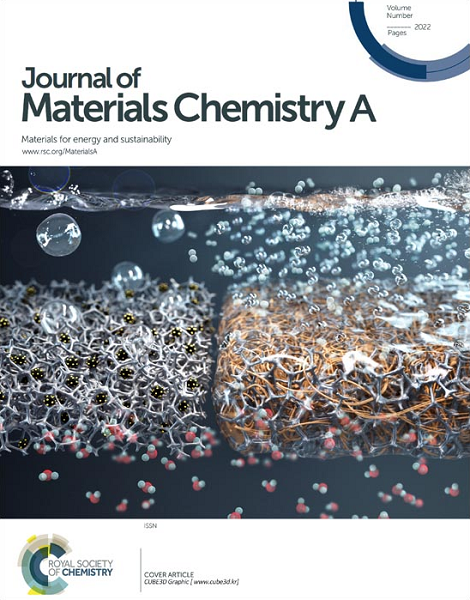Achieving Pt Coating-Free Anodes Using Double-Layered Catalyst Layer Structure for Polymer Electrolyte Membrane Water Electrolysis
IF 10.7
2区 材料科学
Q1 CHEMISTRY, PHYSICAL
引用次数: 0
Abstract
Achieving high-performance and cost-effective proton exchange membrane water electrolysis (PEMWE) necessitates a reduction in the use of precious group metals (PGMs) while maintaining electrolysis efficiency. However, commercial high-activity IrOx catalysts often fail to deliver optimal performance at low loadings because of electron transport problems caused by the natural oxide (TiOx) on the Ti porous transport layer (PTL) surface. This is because the high work functions of IrOx catalysts create Schottky barriers in the low-work-function TiOx, thereby deteriorating the electrical conductivity at the interface. The Pt coating is commonly employed as a protective layer; however, hundreds of nanometers of coating significantly increases the cost of the electrolyzer. To address this challenge, we propose a double-layered catalyst-layer (DL-CL) structure that enables the fabrication of Pt-coating-free anodes, with crystalline, low-work-function rutile IrO2 (R-IrO2) positioned at the PTL interface and highly active IrOx (HA-IrOx) positioned on the membrane side. The key advantage of the R-IrO2 layer over the Pt coating is its porous structure, which effectively prevents contact between HA-IrOx and TiOx with much lower loading (0.1 – 0.2 mg cm-2). The DL-CL minimizes the influence of TiOx on both performance and durability while enabling all PGMs to actively participate in the oxygen evolution reaction.利用双层催化剂层结构制备无铂阳极用于聚合物电解质膜电解
实现高性能和经济高效的质子交换膜电解(PEMWE)需要在保持电解效率的同时减少贵金属(PGMs)的使用。然而,由于钛多孔传输层(PTL)表面的天然氧化物(TiOx)引起的电子传输问题,商用高活性IrOx催化剂在低负载下往往无法提供最佳性能。这是因为高功函数的IrOx催化剂在低功函数的TiOx中产生了肖特基势垒,从而恶化了界面的导电性。通常采用Pt涂层作为保护层;然而,数百纳米的涂层显著增加了电解槽的成本。为了解决这一挑战,我们提出了一种双层催化层(DL-CL)结构,可以制造无pt涂层的阳极,晶体,低功功能金红石IrO2 (R-IrO2)位于PTL界面,高活性IrOx (HA-IrOx)位于膜侧。与Pt涂层相比,R-IrO2涂层的主要优势在于其多孔结构,可以有效地防止HA-IrOx和TiOx之间的接触,其负载低得多(0.1 - 0.2 mg cm-2)。DL-CL最大限度地减少了TiOx对性能和耐久性的影响,同时使所有pgm都能积极参与析氧反应。
本文章由计算机程序翻译,如有差异,请以英文原文为准。
求助全文
约1分钟内获得全文
求助全文
来源期刊

Journal of Materials Chemistry A
CHEMISTRY, PHYSICAL-ENERGY & FUELS
CiteScore
19.50
自引率
5.00%
发文量
1892
审稿时长
1.5 months
期刊介绍:
The Journal of Materials Chemistry A, B & C covers a wide range of high-quality studies in the field of materials chemistry, with each section focusing on specific applications of the materials studied. Journal of Materials Chemistry A emphasizes applications in energy and sustainability, including topics such as artificial photosynthesis, batteries, and fuel cells. Journal of Materials Chemistry B focuses on applications in biology and medicine, while Journal of Materials Chemistry C covers applications in optical, magnetic, and electronic devices. Example topic areas within the scope of Journal of Materials Chemistry A include catalysis, green/sustainable materials, sensors, and water treatment, among others.
 求助内容:
求助内容: 应助结果提醒方式:
应助结果提醒方式:


